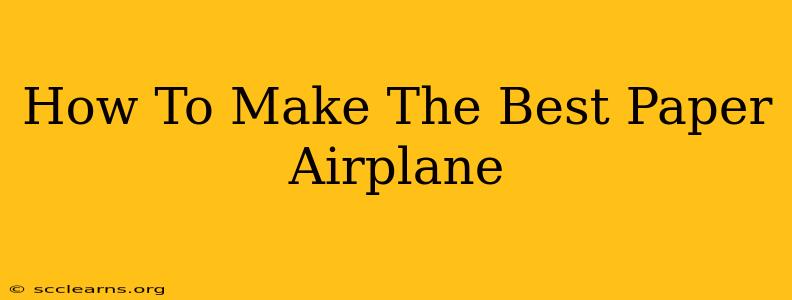So you want to make the best paper airplane? Not just a paper airplane, but the best one – the kind that soars gracefully, flies far, and makes your friends envious. This comprehensive guide will walk you through several designs, from simple beginners' models to more advanced creations, helping you master the art of paper flight.
Choosing Your Paper: The Foundation of Flight
Before we even think about folding, let's talk about the paper itself. The right paper is crucial for optimal performance. Avoid flimsy, thin paper; it'll crumple easily and lack the structural integrity for a long flight. Here's what to look for:
- Weight: Standard printer paper (8.5 x 11 inches, 20-pound weight) is a great starting point. Heavier paper can create a more durable, longer-flying plane, but it can also be harder to fold.
- Texture: Smooth paper generally flies better than textured paper, as it minimizes air resistance.
- Type: While printer paper is readily available, you can experiment with different types like origami paper or even lightweight cardstock for different flight characteristics.
Simple Yet Effective Designs for Beginners
Let's start with some easy-to-fold designs perfect for newcomers. These will help you grasp the fundamental principles of paper airplane construction.
The Classic Dart: A Timeless Design
The classic dart is a simple yet surprisingly effective design. Its sharp nose and angled wings create lift and stability. Numerous online tutorials demonstrate this easy-to-follow fold. Remember to crease your folds sharply for a cleaner, more aerodynamic finish.
The Simple Glider: Maximizing Glide Time
The simple glider focuses on maximizing glide time rather than distance. Its larger wingspan provides more lift, enabling longer, slower flights, ideal for practicing control and observing how wing adjustments affect flight performance.
Advanced Designs for Experienced Paper Airplane Pilots
Once you’ve mastered the basics, it's time to step up your game. These advanced designs require more precision and attention to detail but offer significantly improved flight performance.
The Advanced Dart: Enhanced Stability and Distance
The advanced dart builds on the classic dart, incorporating refined wing folds and adjustments to the fuselage to enhance stability and significantly increase flight distance. This design requires careful attention to detail to achieve optimal flight.
The Boomerang: A Unique Flight Path
The boomerang design takes advantage of asymmetric wing designs to create a unique looping flight path. Mastering this requires practice and understanding of how air pressure affects the airplane’s trajectory.
Tips for Optimizing Your Paper Airplane's Flight
No matter the design you choose, these tips will help you optimize your paper airplane’s performance:
- Sharp Creases: Crisp, well-defined folds are crucial for structural integrity and aerodynamic efficiency. Use your fingers or a bone folder to ensure clean creases.
- Balanced Wings: Ensure both wings are symmetrical. Any imbalance will affect the plane's stability and flight path.
- Proper Launch Technique: A smooth, consistent launch is essential. Avoid throwing the plane too hard or too softly. Experiment with different launch angles to find the optimal trajectory.
- Experimentation: Don’t be afraid to experiment with different designs, folds, and launch techniques. Each adjustment can significantly impact your plane's flight characteristics.
Conclusion: Taking Flight
With practice and a little patience, you can transform a simple sheet of paper into a magnificent flying machine. Remember to start with the basics, master the fundamentals, and then gradually progress to more advanced designs. Happy flying!

